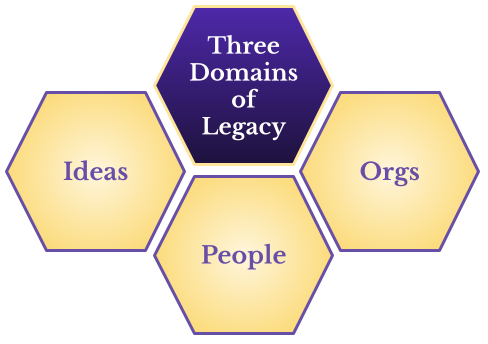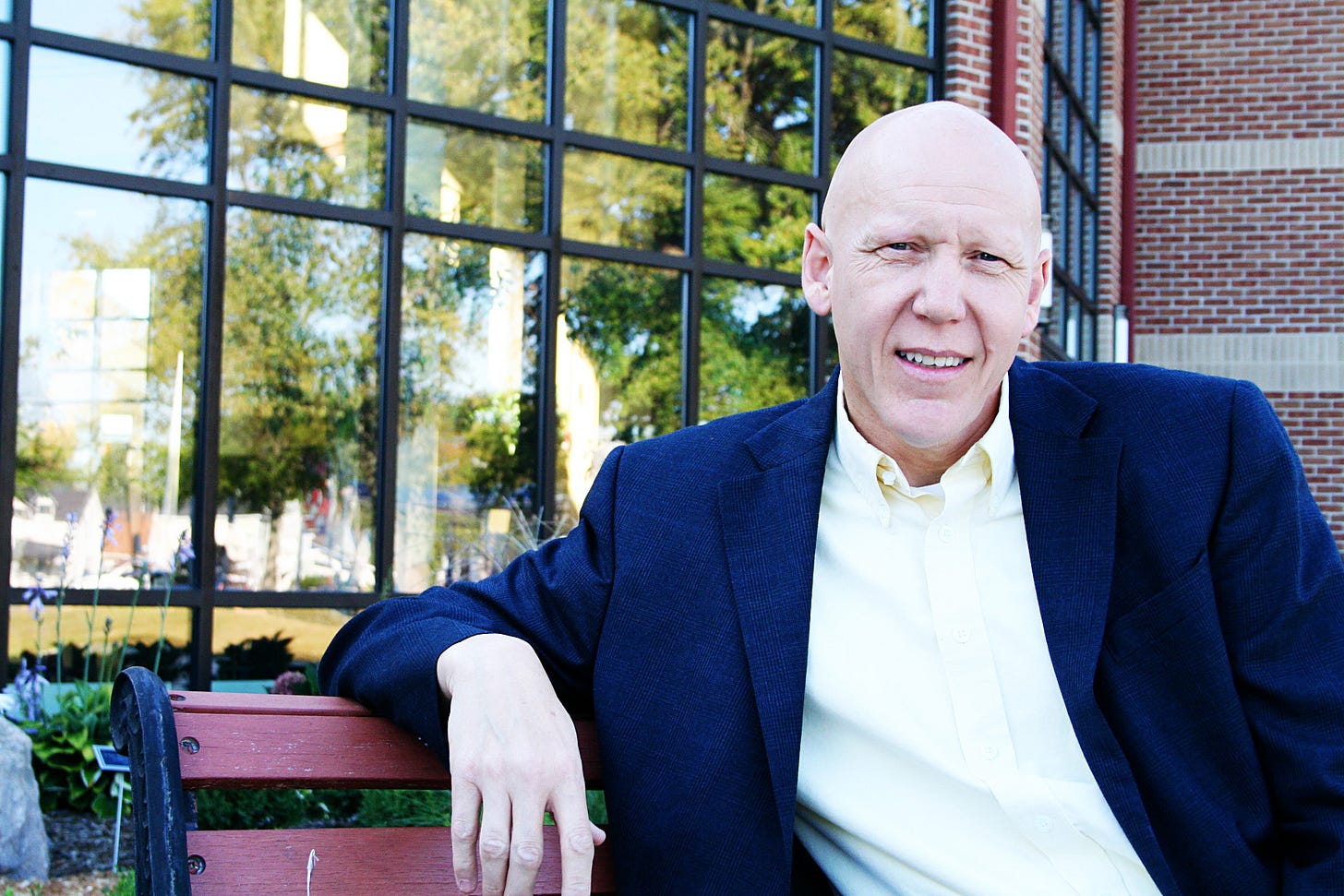Links to The Three Domains of Legacy, a “What Leadership Looks Like” series by David Drury:
Part 1 - Is your primary influence through ideas, people, or organizations?
Part 2 - How ideas can be a powerful influence (feat. Steve DeNeff)
Part 3 - Beyond the cliché of being a "people person" (feat. Jo Anne Lyon)
Part 4 - Building a Lasting Organizational Influence (Feat. Wayne Schmidt)
In the introduction to this series on the Three Domains of Legacy, we learned how each of us influences the world around us in these ways: ideas, people, and organizations (orgs). In what follows, we will learn about the power of influencing through ideas, consider some examples from a leader I used to work with, and then increase our intentionality through ideas.
The Power of Ideas
Nothing is quite so transferrable as an idea. A simple idea can be taught to a four-year-old who knows less than a dozen people and can't name one organization on the planet. Influencing through organizations is impactful, but they are necessarily complex and can be unwieldy to a newcomer. Likewise, influencing through people requires connecting through a networked matrix of nuanced relationships. Ideas don't have that complexity, especially if they are simple and memorable.
Ralph Waldo Emerson said "The key to every man is his thought…. He can only be reformed by showing him a new idea which commands his own."
Ideas foster self-understanding and wisdom that can entirely change a world-view. People share stories all the time about how a new idea truly changed their lives. Ideas become the motivating currency of the narratives of both people and organizations.
We must never forget, however, that ideas only become potent when portable.
Some ideas become so memorable, they are easy to share, thus “portable.” I can't really share my relationships with others. Each person I introduce to another starts from scratch. Organizations can't be shared either, they must be joined. But ideas are potentially viral They adapt and mutate as we each add our own way of communicating or enhancing them.
Ideas spread. It is their nature. An unspread idea is as unnatural as a perpetually-cocooned moth or an ever-tadpoled frog. Ideas fail if only collected and hoarded, but they thrive by being communicated, and thus transformed, through others.
What Does Influencing Through Ideas Look Like?
When I was in my mid-thirties the lead pastor of a large church adjacent to a university took a chance on me and hired me on to be his second chair leader. The title was "Executive Pastor" which might be comparable to a vice-presidential level role or even more like a chief operating officer (COO) in a company. That lead pastor was Steve DeNeff, a master of influencing through ideas. What does Steve do to leverage his idea-inclination and how do the domains of people and organizations also factor into his leadership?
Steve organizes his life around idea generation.
He gets up very early in order to read in the quiet of the day. I’ve noticed that idea-influencers are almost always learners first. The entire time I worked with Steve he had two offices. One was like everyone else's office, for meetings and administrative work. He was in this office just a handful of hours a week, sometimes not at all. The other office was his real office, tucked all the way on the other side of the building, behind the stage, only located by traipsing through a few dark doorways and crooked passageways until you come upon a rehearsal room that seems the dead end of your labyrinthian journey. But off in the corner, behind a door anyone might presume is a broom closet, is found a windowless Benedictine chamber where you can find Steve DeNeff, hunched like Gandalf over a tome in the bowels some mini-Minas Tirith. Steve is always playing with ideas in this space, right up until the time he is to preach. In fact, I would often find him scant hours prior to preaching, photocopying off a section from a large book, in order to read it in the moments before walking on stage. Most preachers have a "research phase" that concludes some days prior to ascending the sabbath chancel. Not Steve.
He leaves open the possibility, by book or by Spirit or both, for new revelation he has not gathered Monday through Saturday.
He allows these to seize him even after the sermon has not only been researched and written but also memorized and perfected for delivery.
Steve prioritizes communication of ideas.
Steve makes several bold choices to communicate ideas. The first is that he preaches, almost invariably, without notes. The reason for this is that in the end he prioritizes effective communication over the absolute perfection of his ideas. This is a hard fought sacrifice for a perfectionist like Steve, but it's one that shows he knows the excellence in articulation of the idea (which would always be more precise with a manuscript in hand) must actually serve the communication of the idea to those who might carry it forward. The ideas are worthless on their own, even if precisely spoken.
Willing, active, and spreading hosts are required for ideas to gain traction.
So, Steve will prowl around the stage gesturing left and right, striding, giraffe-like, to a particular point in space, time, and thought so he might squat down on his haunches, change tone, gather attention, and drive a particular simple point home. Steve is the only preacher I've worked with who stretches, like a track star, before a sermon, sometimes right in the front row as the final song is sung, because of the physical demands his gesticulations will require. You wouldn't want to pull a hammy while exegeting Habakkuk, after all.
Steve empowers others to carry his ideas forward.
Knowing that the portability and transferability of ideas is paramount, Steve doesn't protect his ideas overmuch. He releases them into the wild. Classes and small groups are encouraged to discuss the sermons and the texts used, instead of working through some other curriculum, where his points are torn apart, analyzed, evaluated, dare I say even graded. Since it’s a College Church, there are a fair number of people who grade for a living among his hearers, and even more students, who might enjoy grading someone else for a change on the weekend after getting marked down all week. It is the rare church where as you share the original meaning of a biblical word, a few parishioners reach over on their pew to their Hebrew Bible or Greek New Testament to investigate (and fact-check) what you just said. What's more, Steve has empowered community and business leaders to take his notes, raw and unedited, and re-communicate them to others in conference rooms and around coffee-tables.
His Herculean efforts of idea-generation are followed by a generosity in their propagation.
Perhaps the zenith of my partnership with Steve was on the book SoulShift, where he empowered me to take his ideas and rework them, brand them, and package them not only in the book we co-authored, but in some 40+ other products and resources to support other churches taking the seven shifts of the soul and making them their own so they might have an all-church campaign. But, make no mistake about it, the original ideas are all Steve’s (I still have his original notes.)
These are only a few examples as to how Steve influences through ideas, but again I'll mention that even this model of "ideas, people, and orgs" was a starting idea from Steve, and I've taken it and run with it, perhaps in ways he did not anticipate (especially since I'm writing about him here, something he would never want in the first place.)
I should point out that Steve may not have primary influence through people and orgs but that doesn’t mean he doesn’t have gifts in those areas. He is eminently personable, an extremely close friend of mine, and while much of his idea-generation time requires time alone, he “turns it on” in extraversion, particularly on Sundays, when he needs to do a whole lot of people-time. And, of course, in the ways above and below he influences the building and growth of a great church organization through his ideas as well. I only emphasize the ideas part of his influence because it seems to be the primary and the way he influences the world around him.
How To Influence Through Ideas More Intentionally
My colleague Kevin Batman was always fond of saying to me, "ideas have consequences" as a reminder that ideas are not toys to play with but powerful things that lead to powerful results, perhaps even unintentional ones. How can we be more intentional with our ideas?
It can be tempting to forget the impact people can have.
Ideas need hosts to survive. If you remain cloistered away with your ideas and do not figure out a way for others to engage them, then your ideas grow stale.
Steve would often say to me, in private, "David, ideas are like manna, they spoil."
Idea-influencers pick ideas up off the ground like Israelites every morning, saying to themselves, “what is it?”, then prepare the manna, and serve it to people so it gets used up, often that very day or week. John Steinbeck said, "Ideas are like rabbits. You get a couple and learn how to handle them, and pretty soon you have a dozen." Idea influencers rarely struggle with a lack of ideas. They struggle with implementing them. So effective idea-influencers figure out a way to couple the power of influencing people too (through idea-communication).
It can also be tempting to forget the impact organizations have.
Ideas really gain traction when the systems and culture of a whole organization comes alongside the ideas to execute them in the real world in a sustainable way. Sergey Brin, co-founder of Google, said "It has to be the right idea and have good taste, but the execution and delivery are what’s key." So many idea influencers fail to see their ideas stick because there is no organization they are influencing. Organizations can sometimes be the most frustrating domain for an idea influencer, because ors seem mechanical, traditional, and perfunctory, instead of fluid, progressive, and dynamic like ideas.
But the best idea influencers find a way to influence an org with ideas.
Early in my time with Steve DeNeff I booked us a meeting with Wayne Schmidt (yes, the one I'll be featuring in part 4 of this series) and his executive pastor when they were both leading a large church in Michigan called Kentwood. We picked their brains on their relationship and we learned a ton. One of the key tips came from Wayne giving advice to me. He said that Steve would need all my systems and execution and processes to enhance the organizational impact of Steve's work. But, he cautioned that at times all that would feel restrictive to Steve, and that we needed to find a way for Steve to be "uncaged” from the restraining effects of systems. This is a good lesson for the idea-influencer who feels pinned in on all sides by an org. Just find an avenue to express your ideas with freedom, and you'll find you can contribute to the org just fine as long as you can roar like a lion in some part of your life.
Some of us are idea-influencers but find ourselves in roles where our ideas are not expected or demanded of us.
This can be difficult especially if there is a high expectation of people or organizational influence instead. It can be meaningful to use some of the above approaches to have an impact on people and orgs through your ideas. When you are communicating ideas one on one with a person or even a smaller group, they often don't experience that as an ideas-centric experience. Instead, it feels like a relationship. And an organization has a thousand little points where you can leverage the organization a little to one way or another, with your ideas being the lever. Sometimes it can help to be overt in how you are using ideas for this purpose. Other times you can just keep it to yourself and be content in the knowledge that while your role is not entirely in your sweet spot, you are not still adding value to the world around you in a way that is uniquely you.
Jesus Influenced Through Ideas
Jesus was an idea-person. The sermon on the mount is a stretch of ideas and principles running 2,247 words (almost precisely the length of this article). He was so known for speaking in parables that a gospel writer claimed "...he did not say anything to them without using a parable." (Matthew 13:34b) In a world where their religious text was known as "law" he was fond of saying, "You have heard it said" (while quoting that law) and then offering his own new ideas or interpretation, which might expand greatly or restrict the application of that very law. The new wine of his ideas flowed freely, and while we will see his impact on people and organizations as well, there is no doubt that Jesus was an ideas-influencer.
Watch for "Part 2: Ideas" coming next week here. Be sure to subscribe so you don’t miss it. Also—if you have interest in my SixQ coaching, which is where the Three Domains of Legacy was developed, you can look into the course by clicking here.
So, what's your take?
Where does ideas-influencing fit into your world? If you think it's your primary domain, how did you come to that conclusion and how are you going to work to be intentional about people and orgs through ideas? If it's not, do you know of someone else that you clearly see as an ideas-influencer? Click to go to the comments and interact with me and others there.








The great thing about ideas is that you can communicate them in the context of relationships. Simply investing in people and providing feedback and be powerful.
How do Ideas fit into the way you influence? I’d be interested to hear.